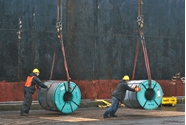Steel Products Prices North America

Foreign Steel Traders Lament
Written by John Packard
April 11, 2019
It took a couple of years, dozens of trade suits, a Section 301 investigation, Changes to the Country of Origin, the Section 232 tariffs and finally a pull-back in domestic pricing to dramatically reduce the amount of foreign steel tonnage coming into the U.S. market. This reduction will not be short-lived. It will continue for many months, according to the traders Steel Market Update spoke with earlier today.
A large international trading company executive told SMU, “Importer’s business today is pretty challenging…the spreads [between domestic and foreign steel pricing] are not sufficient as foreign prices are marginal or at a premium to domestic.” This same executive confirmed their order book was down over the past 4 to 6 weeks.
Another trader told us their business was “not at disastrous levels” and that “niches still work, you just have to look for them.”
![]() We were told that traders not associated with mills that have exemptions such as Korea and Brazil are having difficulties competing against domestic mills. One trader told us he was seeing offers out of the domestic mills around $660 per ton ($33.00/cwt) and foreign HRC prices were $640 to as high as $700 per ton. The traders put the JSW HRC number even lower (down close to $600 per ton). There is not much incentive for a domestic buyer, especially one who believes the next price move by the domestic mills is lower, to make a commitment to buy foreign at, or slightly above, domestic pricing.
We were told that traders not associated with mills that have exemptions such as Korea and Brazil are having difficulties competing against domestic mills. One trader told us he was seeing offers out of the domestic mills around $660 per ton ($33.00/cwt) and foreign HRC prices were $640 to as high as $700 per ton. The traders put the JSW HRC number even lower (down close to $600 per ton). There is not much incentive for a domestic buyer, especially one who believes the next price move by the domestic mills is lower, to make a commitment to buy foreign at, or slightly above, domestic pricing.
The traders told SMU they are buying steel from Mexico, Canada, some from Korea and from the domestic steel mills. SMU discussed the status of the .012 HVAC markets, which had been dominated by foreign steel for many years, and we were told the domestic steel mill price to the end users in the U.S. was “$10 higher than the galvanized base price.” Using that formula and our domestic GI average of $41.75/cwt that would put .012 G30 at $51.75/cwt. We were told that foreign prices were $50.00/cwt-$52.00/cwt USA port.
What will impact the markets and drive domestic buyers back to foreign steel? One trader told us that buyer sentiment, which he felt was negative (rightly or wrongly is another discussion) now and working to hold buyers back from buying. Perhaps more importantly is the situation with inventories. This trader believed flat rolled inventories are higher than anticipated both at the service centers and the end users.
Our own analysis of service center inventories (which is ongoing and will be released to data providers tomorrow) has flat rolled inventories up slightly over the prior month. By our estimation, distributors are balanced to slightly higher and have little incentive to build inventories from here.
Traders told SMU that selling to service centers was especially difficult because of the higher inventories and the domestic mills being aggressive to keep foreign steel at bay.
Another question raised by the traders had to do with the high capacity utilization rates, which are not translating into higher prices. This begs the question of there being potentially too much domestic supply available for the size of the market. Analysts have been writing about this subject, especially in light of the new announced capacities that will be coming online over the course of this year and into 2020. This is a subject that will be discussed directly with the steel mills at our conference as well with a panel of experts who will debate “Steelmaggedon” (trademarked by Bank of America Merrill Lynch analyst and SMU Steel Summit speaker Timna Tanners) and how capacity increases will impact steel prices through the balance of 2019 and into 2020 and beyond. Go to our SMU Steel Summit page for more details.

John Packard
Read more from John PackardLatest in Steel Products Prices North America

Nucor slows HRC price climb with $5/ton increase
After eight weeks of double-digit price increases on hot-rolled (HR) coil, Nucor slowed the price rise this week with an increase of $5 per short ton.

Domestic CRC prices surge ahead of imports
The price spread between stateside-produced CR and imports reached its widest margin in over a year.

Evraz raises plate prices $160/ton
Evraz North America (NA) has followed Nucor and SSAB with a plate price increase of its own: up $160 per short ton (st). The increase was effective immediately for all new orders of carbon, high-strength low-alloy, and normalized and quenched-and-tempered plate products, as well as for hot-rolled coil, the steelmaker said in a letter to […]

Nucor lifts HR coil to $820/ton
Nucor has increased its consumer spot price (CSP) for hot-rolled (HR) coil for a fourth consecutive week.

Nucor pushes HR spot price to $790/ton
Nucor increased its consumer spot price (CSP) for hot-rolled (HR) coil to $790 per short ton (st) on Monday, Feb. 10 – a $15/st bump vs. last week. The Charlotte, N.C.-based company has raised its weekly CSP by $40/st over the past three weeks after maintaining tags at $750/st since Nov. 12, according to SMU’s […]
